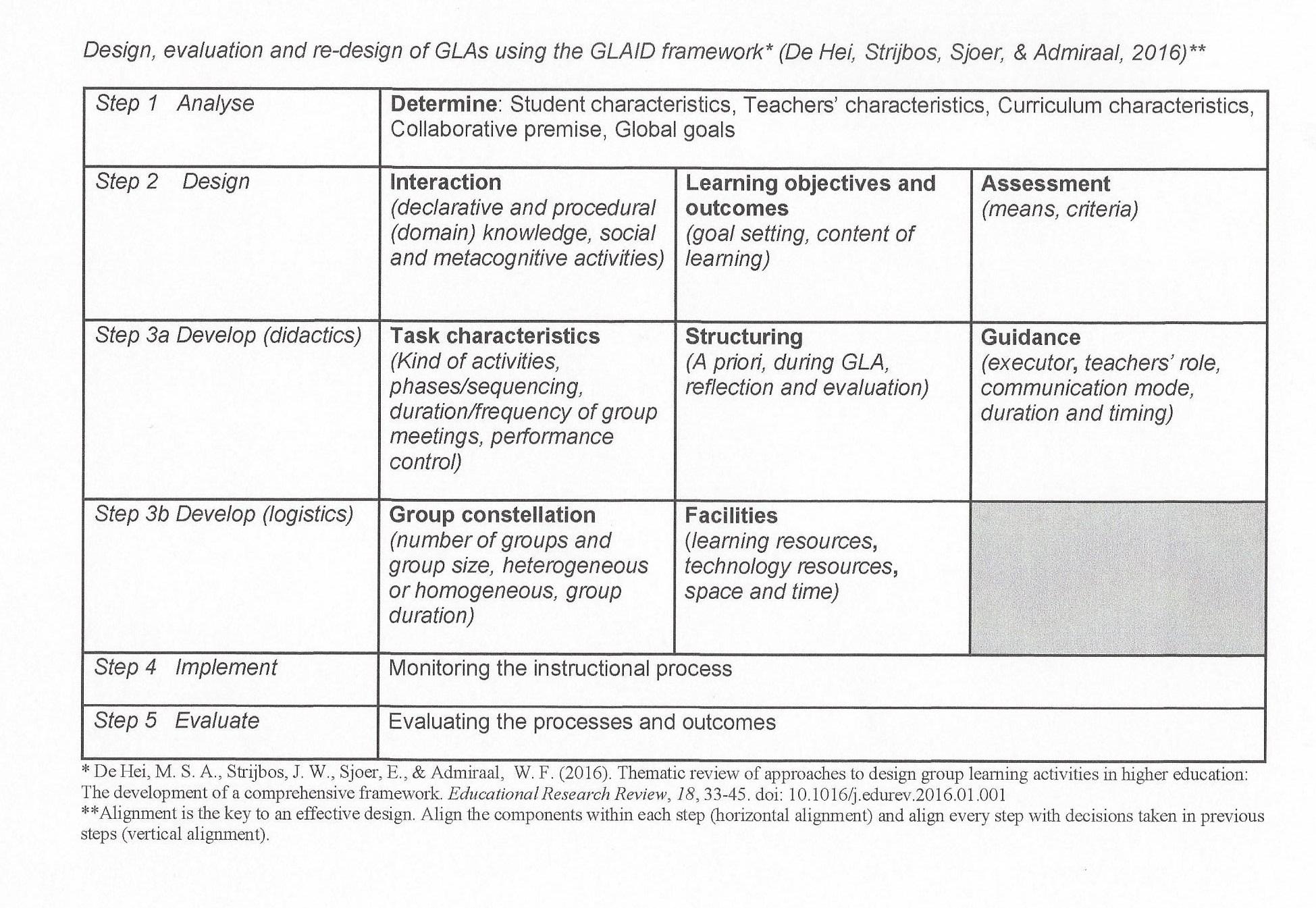Jan Nedermeijer
Thematic review of approaches to design group learning activities in higher education: The development of a comprehensive framework
Miranda de Hei , JanWillem Strijbos, Ellen Sjoer, and Wilfried Admiraal.
PII: S1747-938X(16)00002-6
DOI: 10.1016/j.edurev.2016.01.001 Reference: EDUREV 184. ACCEPTED MANUSCRIPT
To appear in: Educational Research Review.
Abstract
In their article the authors report of a systematic literature search about the group learning activities:
‘Group Learning Activities (GLAs) are a key ingredient of course designs in higher education. Various approaches for designing GLAs have been developed, featuring different design components. However, this has not yet resulted in clear guidelines for teachers on how to design GLAs. The purpose of this thematic review is to synthesize insights from various approaches for designing GLAs into one comprehensive framework. This comprehensive framework, the Group Learning Activities Instructional Design (GLAID) framework, includes eight components:
- interaction,
- learning objectives and outcomes,
- assessment,
- task characteristics,
- structuring,
- guidance,
- group constellation, and
- facilities.
Each component, associated design decisions, and the corresponding design process are described. The GLAID framework aims to guide teachers in higher education in designing, implementing, and evaluating GLAs in their courses’.

Learning outcomes groupwork are often disappointing
In their article the authors indicate that the expected learning outcomes of groupwork are often not achieved. The main reasons according the authors are (the literature references can be found in the article):
(1) ‘Resistance of students and teachers. Payne, Monk-Turner, Smith, and Sumter (2006) found that appropriate scaffolding of group work is necessary to overcome teachers’ and students’ resistance to GLAs.
(2) Problems with the use of technology to support GLAs. Technology to support GLAs, although present, is hardly used, because it is not user friendly or teachers are not trained in the use of the specific technology. Dillenbourg (2013) advocates orchestration, which includes the integration of pedagogy and technology.
(3) Designs of GLAs are not grounded in theories on teaching and learning. Hamalainen and Vahasantanen (2011) conclude that the designs of GLAs should be better grounded in theoretical knowledge about orchestrating, scaffolding, facilitating, and supporting students in the process of shared knowledge construction.
(4) Design components are not aligned. Design components - such as learning goals, task characteristics, instructions on how to collaborate, and support of this collaboration - are worked out separately (Dennen & Hoadley, 2013; Hamalainen & Vahasantanen, 2011; McLoughlin, 2002; Strijbos, Martens, & Jochems, 2004). Alignment of the components means that, in every decision about a component, the designer takes into account every decision made regarding other components in former steps.’
Some implications for the teachers
The practical implications for the teacher in higher education of the newly developed GLAID-framework are described by the authors. For example:
1. ‘In university teaching parts of the curriculum are sometimes fixed and the design has to be aligned with these fixed parts. ………’
2. ‘Parts of a course can already exist for some years, and teachers may want to adjust an existing GLA design for the new academic year. In this case, the components of the GLAID framework can be used to evaluate the design per component, taking into account former experiences of the teacher(s) with this GLA and student evaluations of the GLA. …….’
3. ‘One major aspect to take into account in the design of GLAs is the collaborative premise: the reason why students need to work on a particular assignment collaboratively. If the assignment can be performed equally successful by individual students, this may lead to a resistance to the group work. Teachers should justify why student interdependence is an important part of the learning process and how the collaboration is related to the attainment of the learning goals (Dennen, & Hoadley, 2013). …….’
‘The GLAID framework aims to guide teachers in higher education in designing, implementing, and evaluating GLAs in their courses’.
In the Doctoral Thesis Collaborative learning in higher education: design, implementation and evaluation of group learning activities of mrs. M.S.A. de Hei more information about this research can be found.
The digital version of the thesis can be ordered by mrs de Hei ( m.s.a.dehei@hhs.nl).
